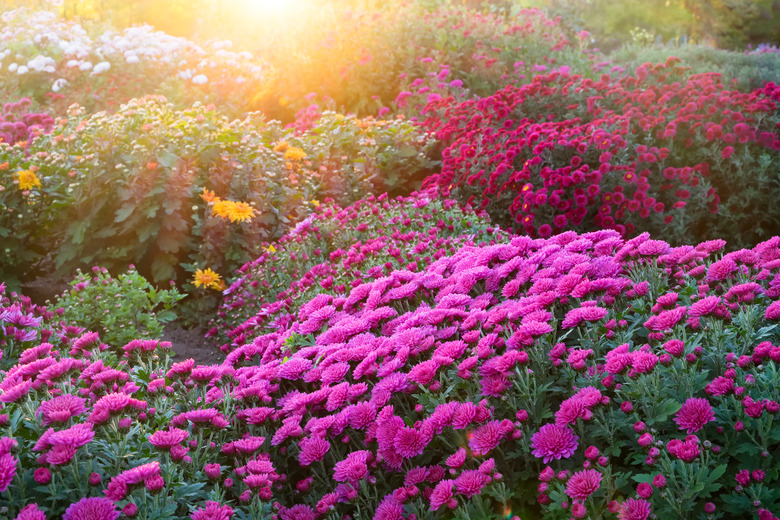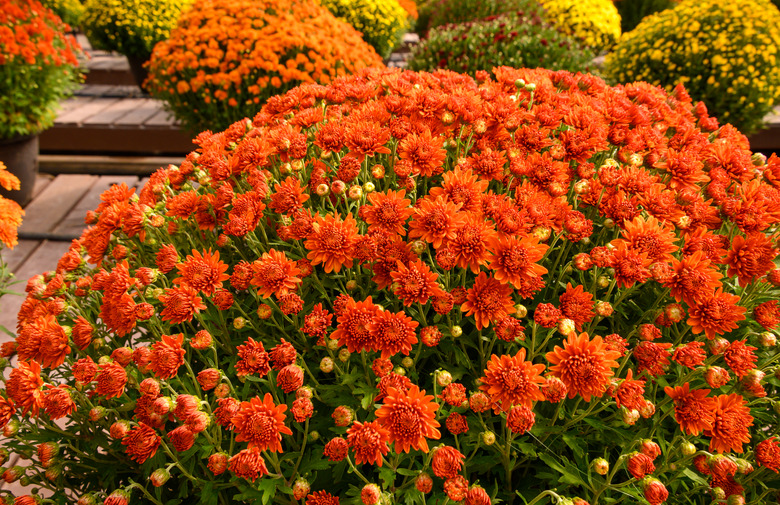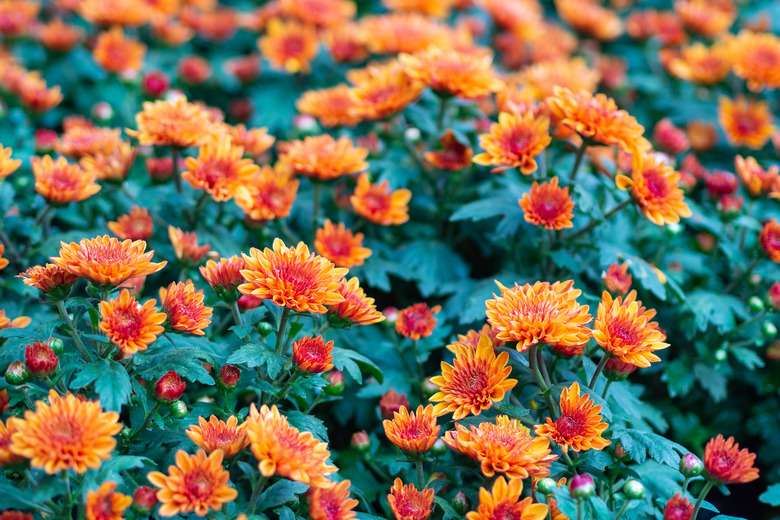How To Grow Chrysanthemums
We may receive a commission on purchases made from links.
- Best uses for chrysanthemums
- How to grow chrysanthemums
- In what zone do chrysanthemums grow best?
- When should you plant chrysanthemums?
- Soil, sunlight and water recommendations for chrysanthemums
- How to propagate chrysanthemums
- How to winterize chrysanthemums
- Common pests and other problems for chrysanthemums
- Common diseases for chrysanthemums
Chrysanthemums (Chrysanthemum x morifolium, USDA zones 5-9) are extremely popular fall-flowering plants that light up the garden from late summer through Halloween or even Thanksgiving in some regions. The plants are not all the same by any means. Some are tiny, some are huge (like the giant spider mums) and you can find them in a vast variety of colors and hues.
Many gardeners buy potted plants in garden stores in September and treat them as annuals, enjoying one season's burst of color. However, mums are hardy perennials that last many years when planted correctly in the right hardiness zones.
Best Uses for Chrysanthemums
Best Uses for Chrysanthemums
Chrysanthemums hail from China, where they were grown as early as the 15th century B.C. as edible herbs. In fact, some people still eat their roots and leaves. The plants — members of the Asteraceae family like marigolds, zinnias and sunflowers — spread to Japan and later Europe and North America as garden ornamentals. Today, they are often sold in pots and are presented as gifts.
Chrysanthemums carry a different significance in different cultures. In France, they are called "death flowers" and are used almost exclusively to decorate grave sites. In China and Japan, they are thought of as symbolizing youth. In the United States, chrysanthemums are most often planted in garden beds, patio containers or indoors in flower pots and are used ceremonially in the South during homecoming season.
Mums are available in a wide range of flower colors, from white to purple and everything in between, with blue-green foliage. You'll find yellow mums, of course, and this is the original flower color, but there are also lavender, pink, red, bronze and orange flowers. Note that each inflorescence is actually composed of hundreds of tiny flowers. Some mums are very small, like the common cushion chrysanthemum, while others are enormous, like the giant spider mum.
How to Grow Chrysanthemums
How to Grow
Chrysanthemums
-
Common Name: Chrysanthemum
-
Botanical Name: Chrysanthemum x morifolium
-
When to Plant: These fall bloomers should be planted in early spring.
-
USDA Zones: 5-9
-
Sun Exposure: Full sun or part sun
-
Soil Type: Loamy, well-drained soil
-
When it's in Trouble: Fall-planted mums will usually not survive a cold winter in the garden.
-
When it's Thriving: Produces lovely blue-green foliage and jewel-tone flowers year after year.
Starting
Chrysanthemums
From Seed
It's not difficult to propagate mums from seed, but you can't be sure what the plants will look like. They are open-pollinated flowers, so you cannot be sure that they will resemble the parent plant.
If you want to grow from seed, start the seeds indoors six to eight weeks before the date of the last spring frost, pressing them into moist potting soil. Expect germination in 10 to 21 days. Thin out the weaker seedlings, leaving only the strongest in each pot. Wait until you see two sets of true leaves and a developed root system before transplanting, usually about eight weeks after planting the seeds. You'll need to harden off the seedlings before transplanting in the garden, setting the plants outside for increasing periods of time for about two weeks. Note that the time span from planting the seed to flowering can be four months.
Starting
Chrysanthemums
From a Seedling
Many gardeners plant chrysanthemum seedlings in the garden bed rather than seeds. The seedlings may be from seeds they started indoors, cuttings they rooted or seedlings purchased in a garden store. They should all be transplanted in the same way in early spring.
Prepare the garden for the mum seedlings by working the soil to a depth of 12 inches. It must be well-draining and moist. Then, work in several inches of organic compost or aged manure to give the little plants nutrients. For potted seedlings, dig a hole for each transplant that is larger than the container and then set each in the soil at the same level that it was in the pot. For rooted cuttings, dig a hole that allows all of the roots to be in soil. Spacing depends on the size of the mum species, so check the label. In general, space the plants at least 24 inches apart.
In What Zone Do Chrysanthemums Grow Best?
In What Zone Do
Chrysanthemums Grow Best?
Chrysanthemums are hardy in U.S. Department of Agriculture plant hardiness zones 4-9. Those gardeners in zone 3 might be able to grow mums in the garden by planting them in a protected area so that they are not killed by the cold winter winds. You should also protect them with plenty of mulch in winter. Alternatively, you can grow mums in containers in cold-winter areas if you move them inside during the coldest weather. In warmer zones, including zone 10, plant them in a place that will get shade in the hottest part of the afternoon.
When Should You Plant Chrysanthemums?
When Should You Plant Chrysanthemums?
It seems that chrysanthemums should be planted in autumn since that is when they make a major appearance at garden stores. Mums of all types and colors appear on the shelves in big pots, hanging baskets and small planting pots, and all are tempting but don't be fooled. If you want to plant mums as perennials — that is, mums that will return the following year and the year after that — you need to plant them in spring.
The chrysanthemums sold in garden stores in fall should be considered annuals. They are already in bud or in bloom when you take them home, and they will not have much energy to dedicate to building a strong root system before winter. Your chances of having an August-planted mum establish and thrive is almost zero in a cold-winter climate.
Soil, Sunlight and Water Recommendations for Chrysanthemums
Soil, Sunlight and Water Recommendations for
Chrysanthemums
Mums like sunshine, and experts recommend planting them far from trees or large shrubs in a site where they will get a full six hours a day of direct sun. However, they will also grow in partial sun with three hours a day or less, although they may become leggy and not produce as many flowers in a shady spot.
These flowering plants need loamy, well-draining soil and will quickly rot in wet soil. They prefer acid-neutral soil rather than strongly acidic or alkaline soil. For best results, add compost, aged manure or other organic matter to the soil before planting.
Newly planted mums need regular water to keep the soil moist. Established mums require less, but when you do water, give the soil a deep soaking. Try to keep all water off the foliage.
How to Propagate Chrysanthemums
How to Propagate
Chrysanthemums
There is no need to pay for pricey container mums if you don't have money to burn. It is easy to propagate the plants you have by taking cuttings or by division. Using either of these methods lets you bring in more mums without paying a dime, and you can quickly get them into their new locations.
To propagate via cuttings, act in spring or early summer. Cut 2- to 3-inch sections of new growth from a stem tip using a sterilized pruner or garden scissors. Remove the leaves from the bottom inch or so of a cutting and push it into moist perlite or peat moss. The growing material needs to stay moist but don't let it become waterlogged. You'll see roots form in a few weeks. Pinch off the top growth to get a wider plant. When the roots are an inch long, they are ready for transplanting.
Spring is also the best time to propagate mums from division. A chrysanthemum plant needs to be divided every three or four years anyway to keep it attractive and flowering. If not, you'll see leggy plants often with bare spots in the center that can die out as they age. Mums benefit from division every three to four years to enhance the form and flowering of the plant. Divide the plant by digging out the root ball and then cutting it into pieces with a soil knife. Some gardeners remove and discard the center of the plant and divide the outer sections only. Aim for three to five sections. Each one can be separately planted as a new mum.
How to Winterize Chrysanthemums
How to Winterize
Chrysanthemums
The steps you should take to prepare your mums for winter depend on the zone where you are gardening. In cold-winter zones, make it a point not to deadhead the mums or cut back the shrubs in autumn. Don't even cut off dead or browning foliage. The old foliage helps to protect the plant's roots, so wait until spring to prune. In addition, pile on the mulch. After the ground freezes, add an additional 4 to 6 inches of mulch.
Alternatively, move your mums into pots after the first fall frost, including as much of the root ball as you can. Water the plants and place them in an area without light that will stay between 32 and 50 degrees Fahrenheit and keep the soil slightly moist. These mums will hibernate, and you can take them outside in spring, introducing them gradually to the light.
Common Pests and Other Problems for Chrysanthemums
Common Pests and Other Problems for Chrysanthemums
Aphids are small and generally harmless, but when a mum plant has an aphid infestation, you need to take action. These pests are small and soft-bodied, and they have tiny mouthparts that allow them to pierce the leaves of a plant and suck out the nutritious juices. Look for them on the bottom of the leaves or on the stems just below a bud. They are easily removed with a blast of the hose.
Spider mites are also miniscule, but they are not insects. Rather, like spiders, they are a type of arachnid, and they are so small that you will find them difficult to spot. They are often white but can also be darker colors or even red or yellow. Look for them under the leaves but particularly look for the silky webs they spin to protect themselves under leaves or at leaf joints. You might also see brown spots on the leaves. Get rid of these pests by blasting them off with a hose.
Common Diseases for Chrysanthemums
Common Diseases for
Chrysanthemums
Powdery mildew is among the easiest diseases to recognize on a plant leaf since it looks like someone spilled flour or powdered sugar on it. This is a fungal disease caused by too much moisture on the leaves and not enough air passing between them. Prevention involves planting your mums in full sun, watering them from the ground and not from above and spacing them far enough apart that the outside leaves can dry in a breeze. To minimize existing powdery mildew problems, prune out and throw away infected foliage (never in the compost pile).


